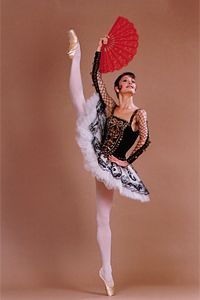
Irma Nioradze (the biography)
| |
Tell us, Irma, what it felt like when the Russian President awarded you the title of People’s Artist?
It was like a fairytale. For me it was a very special occasion because before me Maya Mikhailovna Plisetskaya, one of the world’s greatest ballerinas, received a government award at a ceremony attended by leading Russian cultural figures. It was great, it was an honour, it was exciting. Very exciting. I even thought that it was easier to dance than to accept an award.
As a ballerina you have had an interesting stage career. What has helped you achieve goals in your profession?
There have been times when I didn’t know what to do and what decisions to take, but it would appear that by good fortune my guardian angel has always looked over me. The fact that I have been so lucky is due to my brilliant teachers. Each of them gave me something special, of their own, and each of them helped me find my inner “self.” For two years I studied under Vakhtang Chabukiani – I graduated from his class. In the girls’ ballet class I studied under Serafima Vekua, she was a great representative of the Italian school. It was not my connections but my teachers that helped me. Among them were Natalia Zolotova, Lyudmila Safronova, Olga Moiseyeva and Ninel Kurgapkina. I can’t but remember Georgy Alexidze, we did a whole series of contemporary ballets together, and also Oleg Vinogradov who invited me to join the Mariinsky Ballet Company. Onstage I had the good luck to appear with some of the great dancers of the older generation. And I felt that next to them I was growing as a dancer.
How did you get into Vakhtang Chabukiani’s class – was that just by chance?
In life it is probably very important to be able to make an impression. But at the same time you have to realize you have no right to do it. I remember well in ballet school, it was my first year, and they were choosing the cast for the lead roles in The Sleeping Beauty. I really wanted Chabukiani to like me and I remember asking my teacher if I could audition too, although the role of Aurora was only given to graduates. And in the tempestuous pas de bourrée I shot past Vakhtang Mikhailovich. He spotted me and gave me the role of the Lilac Fairy. It was a great honour for someone still in the first year. In my second year I danced a ballet to Weber’s music Aufforderung zum Tanz, and I graduated in Laurencia. Vakhtang Mikhailovich was a genius. He had a great influence on me and I owe him a very great deal. I only dance The Dying Swan because of the secret to the performance that he revealed to me. When I become a teacher I will try to pass on this priceless knowledge to my students.
Why did you leave Tbilisi – at that time you were a soloist at the Paliashvili Theatre?
I always wanted to train in Leningrad. When I left Tbilisi I asked Vakhtang Mikhailovich’s blessing. He approved of my decision, although he considered I was already ready to appear as an independent artist. As a seventeen-year-old girl I came to the Vaganova Academy where I trained for one year. After the course I went to America, to the Jackson Competition, which I won, and then I was a trainee for two months at the Danish Royal Ballet. Then I was supposed to return to America – I had a contract waiting for me. But in 92 I came back to St Petersburg and joined the Mariinsky Theatre. I had always dreamed of dancing there, it’s so packed with living tradition. It was very difficult for me; it was like finding my way through a labyrinth. But it seems it was my destiny to overcome all the obstacles that lay in my way. I love taking risks. And in individuals I like the “warrior character”, how people choose their own paths.
After so many years what do you remember from your first experience of the theatre – hard work or vivid memories of your first roles?
At the theatre I had Olga Nikolaevna Moiseyeva, a brilliant teacher. And I have to say if it wasn’t for her, my rock, I might have given up. It was hard. It was hardest to assimilate the performing style for which the Mariinsky Theatre is so famous. I worked on that with Miseyeva for three years. My very first roles were in the ballets Le Corsaire, Giselle and Don Quixote. I do remember one thing – when I was rehearsing my absolutely favourite ballet The Legend of Love the rehearsal was on the upper stage. The production was ready but some important nuance was missing. And when Olga Moiseyeva saw there was something in my dance she suddenly stopped the rehearsal. She said if you don’t know the character you are dancing and are just performing the role technically then you should not go onstage. I left the rehearsal in tears. It was a bitter experience, but from that time onwards I listened to her every word. She had the ability to “draw out” a person’s character and help you find your way in a role.
Later you worked with Ninel Kurgapkina until her very death. Which Irma within you did she bring to life?
Working with Ninel Alexandrovna was amazingly interesting and productive. It was a long and arduous path with interesting discoveries and ups as well as downs. After a good rehearsal I always had a cup of tea with her in the cafeteria. I can remember many amusing situations. I recall that when I was rehearsing the role of Aurora in The Sleeping Beauty with Ninel Alexandrovna at the rehearsal of the Adagio with the four suitors I smiled a great deal and she said “You shouldn’t smile. You are a well brought-up princess. One of them comes, you smile and you look at your mother and then change your expression. You have to imagine you are Queen Tamara or Catherine II.” And Ninel Kurgapkina also helped me develop my focus and self-confidence.
How do you develop the capacity for work without which a career in ballet is impossible?
I admire three things in people – honesty, courage and being able to choose your own path. Some people are lucky and others not. But you have to be able to find the strength. Patience can help you overcome anything. You have to be able to change minor into major. And let me repeat Moiseyeva’s artistic credo: if you don’t know what you want to say to the audience don’t go onstage. For almost twenty years of theatre appearances I have followed that rule. And it’s also important not to forget it can all disappear. I still remember the words of Natalia Viktorovna Zolotova after I won a competition the programme for which we rehearsed together: “Achieving is only half of the matter – retaining the achievement is what it’s really all about.”
Does working in the theatre ever become a routine, or does a prima ballerina never even have such thoughts?
I couldn’t live without the theatre. I love my coaches, partners, fellow dancers, the stage directors and the wardrobe mistresses. I love when I hear them saying “twenty minutes till the start of the performance.” I can’t live without those words, I just can’t – without the smell of the stage, without the stage sets and these historic brick walls. There is, however, a huge “but”: a performance is an entire story that begins twenty days before with the rehearsals. And that story is made up of a chain of incredibly important details on which the success of the entire performance ultimately depends.
Have there ever been times when one of those details has been lost? After all, you can’t always foresee everything?
There was one time when I was dancing in a premiere of Le Corsaire at the Opera di Roma in 2008 and the stage lights suddenly went out. The orchestra continued to play and we were dancing in the dark. I whispered in my partner’s ear “Keep going till the end of the act.” We focussed our eyes on the white dress of Carla Fracci who was waiting anxiously in the wings. It saved us, and the audience (there were guests from Milan, Venice and Florence) was so grateful, understanding how hard it had been for us. If we had stopped the gala would have been ruined. And then there was such a magnificent review: “Mariinsky Theatre soloists saved the premiere, praise and glory to them. Risking a great deal they performed to the end, portraying a plethora of emotions.” Yes, you can’t foresee such situations, and you remember them for the rest of your life.
You have tackled so many difficult roles and created so many vivid images – is there anything left?
I’ve always had the wish to create and discover new things. I don’t like sitting still, it’s not me. For example, I’d like to work in the film industry. I’ve already had the good luck to do that, it was a minor recurring role in Sergei Debizhev’s film The Golden Mean. It’s true that at the time I couldn’t devote myself to film, but in the future it’s a definite possibility. I really like film work.
Can you share some ballet secret with us?
I’ll tell you a secret from my own experience that might be useful to ballerinas that can’t look their partners in the eye. Although they can all do that nowadays (laughs). In Giselle you have to “draw out” the glance when Albrecht swears his love for Giselle. And as Giselle was my first role in the theatre I was shy to look my partner in the eye for a long time. And somehow my partner asked “Why do you turn your eyes down? Am I really that ugly?” It was so hard not to laugh. And then I thought up a trick for myself – I realised that when I look at beautiful flowers my gaze freezes and I decided that during a performance I would imagine that there were flowers blossoming in my partner’s eyes. And the trick worked. And I truly hope the next generation has tenacity, works well and that they don’t rest on their laurels but keep striving towards perfection. |

